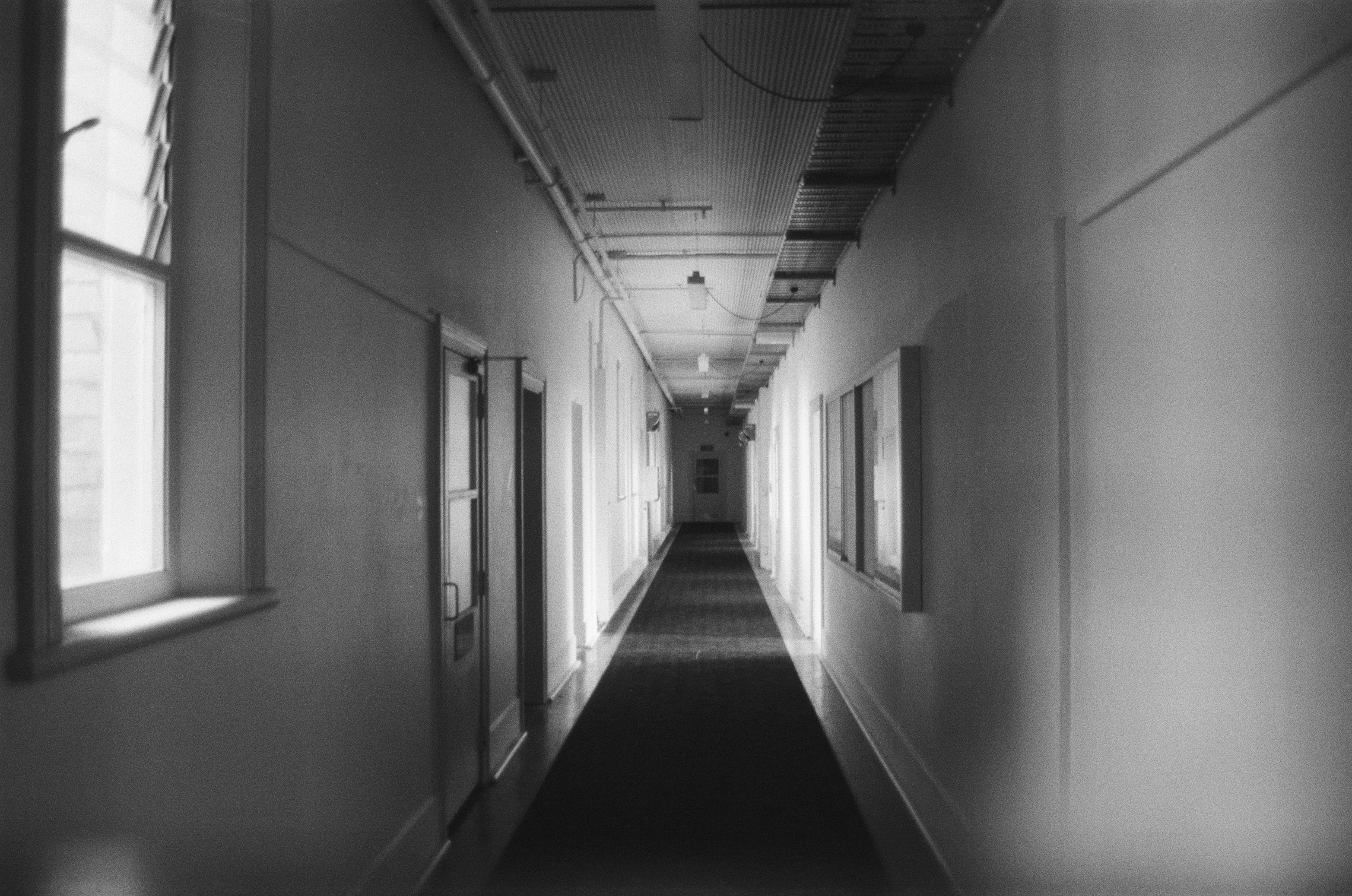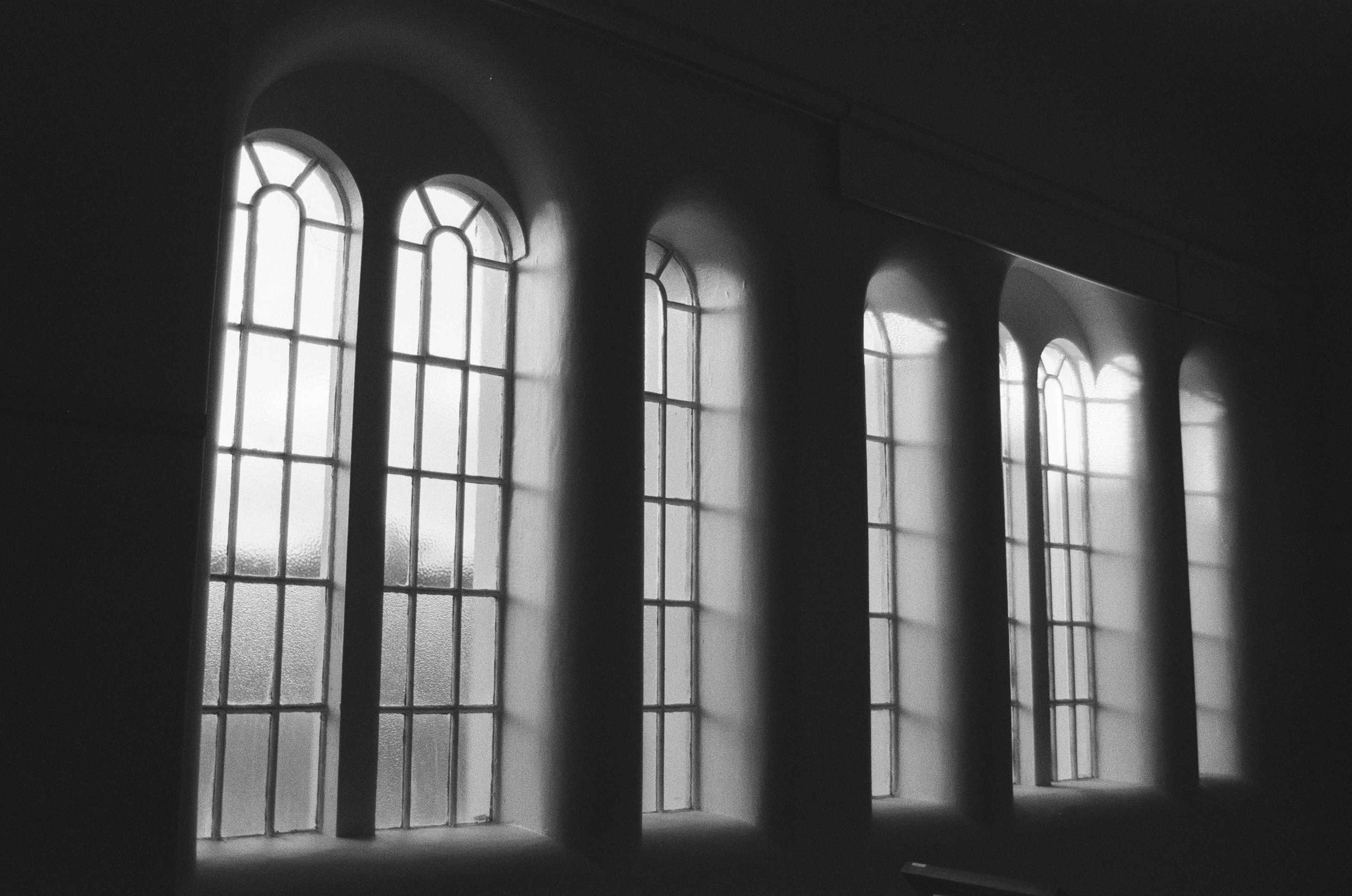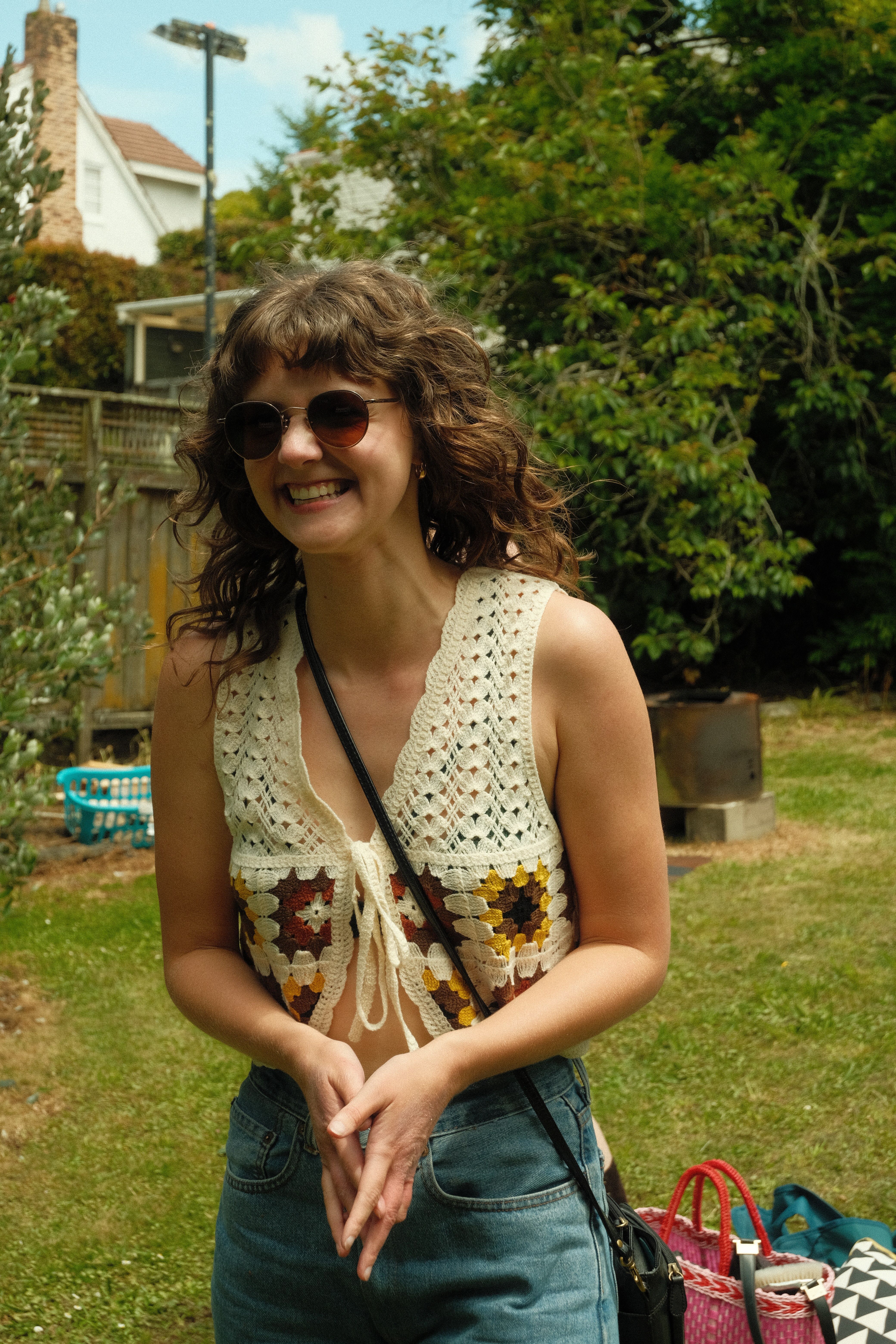Ghost Stories
Don’t look away. Amelia Jacobson dives into Aotearoa’s history of ableism and disability justice while unravelling the myths of the Unitec Campus.
TW: Discussion of ableism and eugenics.
Two tiered
we are defective
shit, thanks Sir Truby King
born in this body, it did not happen to me
I am not a solider returning from the battlefield
in line to be rehabilitated
back to a cog in the wheel
instead, you call us lazy
bottom feeders
exaggerating, hysterical
so I work hard, pushing
punishing
the subconscious sense of something to prove
On the 3rd of August 2022, Christopher Luxon, leader of the National Party, said:
“The bottom line here is that anyone in a job is a good thing, that’s the pathway to dignity. You’re not going to get rich sitting on welfare and being confined to welfare all your life.”
Locked up
you confined them
over-medicated
forced sterilisation
removed all privacy
I read somewhere, they used to say
disability care was
cradle to unmarked grave
tell me, is that what dignity feels like?
Cradle… to unmarked grave.
If you walk around these places, can you feel it?
Ways of seeing
On the ground floor of Building One in the Unitec library, I discovered disability theory and concepts of disability justice for the first time. Voices loud with rage, with joy, with opinion and expression, taking up space at the intersections of discourse. These words crafted by other disabled people offered me a mirror, not only to feel seen but to a new way of seeing. Sitting in this place, with identical windows to sprawling brick, designed to confine – I began to explore taking up space.
To be a part of the social world, I must sit: brace myself, block body from mind, steel will. To lie down is to absent myself from ordinary spaces. I wonder how many of us there are skulking in the in-between spaces. And I wonder at how such an everyday action, a simple thing born of necessity, became something to conceal. What taught us our shame? – Liz Crow, Lying Down Anyhow: Disability and the Rebel Body, 2013
Unitec Campus. Photography by Benny Joy
Ghost stories
It’s 2018, Orientation Day for Performing and Screen Arts, and I’m standing outside the Unitec theatre. The hum of nervousness, everyone assessing each other – guessing who was an actor, dancer, or film student. We were all asked to come into the theatre and sit on the hard floor, while staff members gave speeches on how we’re all embarking on learning how to tell stories. Sitting on that floor, struggling to hold myself up, my ribs aching, I assumed everyone around me felt the same. Not yet having the language of access needs, I suffered through. Once the speaking was over, we were all asked to stand and walk together down a hill to another part of the campus. I got up quickly, attempting to match the pace of the crowd around me, but anxious about dislocating a joint in the process.
Sitting on that floor, struggling to hold myself up, my ribs aching, I assumed everyone around me felt the same.
After orientation, I hung around to chat with a few of my new classmates. The topic of the campus and its history came up, as we swapped the ghost stories of hauntings and strange happenings. Immense and sprawling, the Unitec campus stands out in Mount Albert suburbia. It’s no secret what the campus once was, having held numerous names since its construction in the 1800s: Auckland Lunatic Asylum, the Whau Lunatic Asylum, Auckland Mental Hospital, Oakley Hospital, and later Carrington Psychiatric Hospital. It has been surrounded by a mythology of discomfort and othering, known by the community – but separated. Many have stories of some kind of encounter, visiting a family member who was a patient, or the echoes of neighbourhood rhymes taught to instill fear and control children’s behaviour. My own assumptions had been based on the era of its architecture: conjuring gothic images of Victorian asylums, girls in white nightgowns, burning candlesticks, and harrowing experimental treatments.
What is myth, legend, or truth?
Hostile spaces
The year before I started my studies, I came onto campus for a course interview. Something felt off, strange yet familiar, as I walked into a narrow corridor lined with offices, on the bottom level of one of the strange buildings. The fluorescent light flickered as the course co-ordinator asked me questions, and I felt a sense of confinement. Struggling to stay present, I explained I was recovering from a recent surgery. Concern flicked over her face as she emphasised the intensity of the programme, checking that this would not be an ongoing issue. I reassured her that I was fine, I was prepared for the pace. She continued with a warning, that people with “underlying things” find they bubble up in the second or third year of the programme, and wanted to confirm that wouldn’t be me. I reassured again, the unease of the clinical space crawling against my skin.
In my first year at film school, I hummed with intensity, striving to stand out while also seeking a sense of collaboration and belonging. Arts training often evokes a sense of competition, preparing for a pathway with a scarcity of resources, so only those who really want it and can sacrifice everything will survive. It’s a narrative my internalised ableism clung to, and I chose to over-compensate for the difference in my body, pushing hard to prove I was disciplined enough, passionate enough, and that I was enough. This laser focus distracted me for a while and took me out of my body.
Arts training often evokes a sense of competition, preparing for a pathway with a scarcity of resources, so only those who really want it and can sacrifice everything will survive.
Every day, I would navigate through the campus maze, the winding corridors and narrow staircases, spaces separated by multiple sets of heavy doors. I couldn’t grasp why I experienced these spaces so viscerally. A hostility began to seep under my skin.
From childhood, my body has been assessed, scanned and adjusted. Something was different about me, but nobody could name it until my adulthood. As I shuffled across linoleum floors wearing ill-fitting hospital gowns, the walls were lined with images of children with strange metal things drilled into their limbs grinning ear to ear, framing the bend from defective to normative. Lying on examination tables, I would close my eyes under the harsh florescent lights, machines beeping, waiting – so much waiting in spaces that disconnected me from my sense of agency and autonomy.
These images flash together – as memories or my own mythologies?
Oakley Hospital, later Carrington Hospital, 1977. From Auckland Libraries Heritage Collections 435-09-33. Photographer: Philip Doyle
I started asking probing questions, but the information wasn’t easy to source. What happened in these spaces? What are these walls carrying? My morbid curiosity pulled these loose threads and I needed to look between the gaps to find the unsaid and the hidden things.
There was a personal, geographical, even linguistic exclusiveness in this community of the insane who yet had no legal or personal external identity – no clothes of their own to wear, no handbags, no purses, no possessions but a temporary bed to sleep in with a locker beside it, and a room to sit in and stare, called a dayroom. Many patients confined in other wards of Seacliff had no name, only a nickname, no past, no future, only an imprisoned Now. – Janet Frame, An Angel at My Table: An Autobiography, Volume Two, 1984
I would pass the door to the morgue every day, a constant reminder. The tunnel system running underneath the maze to transport bodies now blockaded, hidden. Unease lingered – by focusing on the horror, was I also becoming complicit in its mythologies? I tried to move on, but couldn’t. The stories in these walls were stuck and lingering, sharp thorns burrowing deeper into my flesh.
Acting studios had been dayrooms,
a room to sit in and stare.
Lecturers’ offices had been seclusion rooms in the women’s ward, with observation windows for patients to be
stared at.
Rotten roots
One of my lecturers had been a student in the 90s when Unitec first took over the site, and on his first day found patient files scattered across the floor, an afterthought, abandoned. In the mid-1980s Carrington was still bursting at the seams, and I’d only begun to comprehend just how recent this was. Institutionalisation is often thought of as part of our earlier history, a past brutality necessary in the harsher times of the new ‘colony’.
The Immigration Acts that discriminated against Chinese people in the late nineteenth century also sought to deter disabled people. The 1882 Imbecile Passengers Act restricted “cripples, idiots, lunatics, infirm, blind, deaf and dumb”, and the 1899 Immigration Restriction Act banned the “idiotic”, the “insane” and the “contagious”.
New Zealand was framed as a fantasy, to entice the journey across the world, a utopia, an uncorrupted Garden of Eden – a new, better Britain. The roots twisting under these mazes are rotten, knotted deep into the earth. A base for bricks and mortar – eugenics, the scaffolding of the many institutions across the country. Now they are only rubble, repurposed or abandoned. The ideas that built them are not.
Group of assistants at Auckland Mental Hospital. Photographer: Margaret Matilda White. (Source: Auckland Museum)
Many of the people in positions of power shaping the health system were invested in the global eugenics movement of the 19th century.
These small islands at the bottom of the world,
stolen land, a ‘nation’ built on mass violence and severing of agency,
presented an opportunity to experiment, with policy aimed at ‘weeding out defectives’ from generations. Upheld by propaganda perpetrating the narrative of this group as a burden and threat to society. This was the approach favoured by the likes of Truby King, Medical Superintendent of Seacliff Asylum and founder of the Plunket Society. Ableism was blatant across the health and welfare system until shapeshifting into the medical rehabilitation model that evolved in the wake of injured soldiers returning to the workforce post-World War II. A thinly veiled disguise; if you are ‘fixed’ or ‘cured’, then you have value in society.
Hysteria
From my teens, I absorbed narratives about emotional women, difficult women, hysterical women, and the fear of this label and the pathologising of my pain seeped into my subconscious. So I was compliant, warm, and medically articulate, but never overstepping to claim I knew my body better than the experts. These concerns were solidified in 2018, when I read an article about Stephanie Aston, a young woman with the same condition as me, who continued to advocate for herself despite being labelled with factitious disorder – a modern iteration of hysteria – and denied medical care. This September, years after I began this unravelling, I heard she had died. These are not problems of the past. I think of the stories of women like Johanna Beckett, who was admitted to Seacliff Asylum in the 1900s, who subversively asked during her clinical photo, “Do you want a picture of a madwoman? I’ll put straw in my hair and make faces.”
Johanna Beckett. Source: Archives New Zealand: Seacliff Mental Hospital Statutory Admission Papers DAHI 19850 D266/17/2116 / R25258208
Pandemic narratives
In March 2020, Prime Minister Jacinda Arden introduced the system of alert levels and calmly explained the lockdown of the entire country, in a press conference burned into all our brains. As someone who is at higher risk for Covid-19, I was relieved to have the decision taken out of my hands – a collective response, rather than another thing I would have to navigate and feel separated for. It was refreshing to hear language focused on protecting each other. The global discourse had a darker tinge, bringing eugenics and ableist narratives into the mainstream with figures across sectors debating whether people like me would need to be collateral damage. Through weaving a palatable story with theory and jargon, we were dehuminised – us and them, sacrifice the vulnerable for the economy. In a mythology of scarcity, there is not enough to go around – forced DNR orders on people with underlying conditions and infections ripping through residential care facilities because Whose life is worth saving? As people complained about cancelled events and lockdown boredom, my existence was questioned on the global stage. Physically, I left the campus, but those spaces still felt heavy in my body. Those in power condition society to be separate from us, and other us. It makes it easier for the masses to not notice that we are missing.
I refuse to be a footnote in history, only an echo. As disabled people, we should be able to take up space in our fullness,
Eugenics and ableist theories shifted into policy – into action – in the aftermath of the 1918 flu pandemic, and only fell out of popular favour when Hitler took them to the most extreme in Aktion T4, with disabled people as test subjects for mass-genocide methods later used in the holocaust. We lack first-hand accounts of this piece of history, because so few survived. The waves of history are cyclical; the tide turns and history repeats. The global pandemic response has begun to erode the hard-won rights of disabled people, which were catalysed by the direct action of the disability rights movement in the 1970s. I refuse to be a footnote in history, only an echo. As disabled people, we should be able to take up space in our fullness, and in pride for the legacies of resistance that allowed us to weave our own narratives. We carve out this space through the joy, pain and humour in our shared stories.
Later in 2020, I returned to campus to shoot my graduate film, in the re-abandoned Building One. Unitec handed the site to the Crown, while reports and survivor testimony from The Royal Commission of Inquiry into Abuse in Care began hitting the mainstream news cycle. The violence that had been buried in institutions around the country for decades was beginning to be excavated.
I spent a day moving through the empty spaces alone, writing this diary entry in response.
Turning a corner of one of the wings, my stomach drops, twisting, a heaviness in my limbs, my muscles tightening, even the wide spaces feel constricting, sunlight unable to break through. I keep walking, into a narrow corridor, lined with identical concrete cells. I step into one, the tiny sliver of window so high, I can’t look out of it. I trace my hand along the scratches, tally marks and words carved into the walls. I feel it in my body, the stories carried in these heaving walls. Glimmers of expression and communication in an environment of suppression.
I often wonder, if I had not been in that space at that time, felt and experienced this history – in my disabled body – would the unravelling have begun? Would the conceptualisation of my disabled identity and the medicalised and ableist systems I navigate be different? I’ve crossed the threshold to an - other space.
My emotionality is resistance.
My humanness is resistance.
My aliveness is resistance.
I will not repress my rage
Or
my joy
to manage the discomfort of others.
And maybe our stories will not be marked only by suffering and survival.





